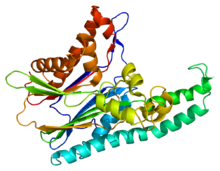- MAP3K7IP1
-
Proteína de interacción 1 con la MAP quinasa quinasa quinasa 7 
Estructura tridimensional de la proteína MAP3K7IP1.HUGO 18157 Símbolo MAP3K7IP1 Símbolos alt. 3PK, MAPKAP3 Datos genéticos Locus Cr. 22 q13.1 Bases de datos Entrez 10454 OMIM 602615 PDB 2j4o RefSeq NP_006107 UniProt Q15750 La proteína de interacción 1 con la MAP quinasa quinasa quinasa 7 (MAP3K7IP1) es una enzima codificada en humanos por el gen MAP3K7IP1.[1] [2] [3]
La proteína MAP3K7IP1 fue identificada como un regulador de la MAP quinasa quinasa quinasa MAP3K7/TAK1, la cual está implicada en diversas rutas de señalización intracelular, tales como aquellas inducidas por TGF-beta, IL-1 y WNT-1. Esta proteína interacciona y por ello activa a la quinasa TAK1. Se ha demostrado que el extremo C-terminal de esta proteína es suficiente para la unión y activación de TAK1, mientras que el extremo N-terminal actúa como un inhibidor dominante negativo de TGF-beta, lo que sugiere que MAP3K7IP1 podría funcionar como mediador entre los receptores de TGF-beta y TAK1. Esta proteína también puede interaccionar y activar la MAPK14 y por ello representa una ruta de activación alternativa, además de la ruta de las MAPK quinasas, que contribuyen a la respuesta biológica de MAPK14 a diversos estímulos. Se han descrito diversas variantes transcripcionales de este gen, que codifican diferentes isoformas de la quinasa.[3]
Interacciones
La proteína MAP3K7IP1 ha demostrado ser capaz de interaccionar con:
- ZMYND11[4]
- MAPK14[5]
- SMAD7[6] [7]
- TRAF6[8] [9] [10]
- MAP3K7IP2[11] [12] [8]
- XIAP[13] [14]
- MAP3K7[12] [15] [9] [16]
- MAP3K7IP3[12]
Referencias
- ↑ Shibuya H, Yamaguchi K, Shirakabe K, Tonegawa A, Gotoh Y, Ueno N, Irie K, Nishida E, Matsumoto K (Jul 1996). «TAB1: an activator of the TAK1 MAPKKK in TGF-beta signal transduction». Science 272 (5265): pp. 1179–82. PMID 8638164.
- ↑ Sakurai H, Miyoshi H, Toriumi W, Sugita T (May 1999). «Functional interactions of transforming growth factor beta-activated kinase 1 with IkappaB kinases to stimulate NF-kappaB activation». J Biol Chem 274 (15): pp. 10641–8. PMID 10187861.
- ↑ a b «Entrez Gene: MAP3K7IP1 mitogen-activated protein kinase kinase kinase 7 interacting protein 1».
- ↑ Kurozumi, K; Nishita M, Yamaguchi K, Fujita T, Ueno N, Shibuya H (Apr. 1998). «BRAM1, a BMP receptor-associated molecule involved in BMP signalling». Genes Cells (ENGLAND) 3 (4): pp. 257–64. ISSN 1356-9597. PMID 9663660.
- ↑ Ge, Baoxue; Gram Hermann, Di Padova Franco, Huang Betty, New Liguo, Ulevitch Richard J, Luo Ying, Han Jiahuai (Feb. 2002). «MAPKK-independent activation of p38alpha mediated by TAB1-dependent autophosphorylation of p38alpha». Science (United States) 295 (5558): pp. 1291–4. doi:. PMID 11847330.
- ↑ Edlund, Sofia; Bu Shizhong, Schuster Norbert, Aspenström Pontus, Heuchel Rainer, Heldin Nils-Erik, ten Dijke Peter, Heldin Carl-Henrik, Landström Maréne (Feb. 2003). «Transforming growth factor-beta1 (TGF-beta)-induced apoptosis of prostate cancer cells involves Smad7-dependent activation of p38 by TGF-beta-activated kinase 1 and mitogen-activated protein kinase kinase 3». Mol. Biol. Cell (United States) 14 (2): pp. 529–44. doi:. ISSN 1059-1524. PMID 12589052.
- ↑ Yanagisawa, M; Nakashima K, Takeda K, Ochiai W, Takizawa T, Ueno M, Takizawa M, Shibuya H, Taga T (Dec. 2001). «Inhibition of BMP2-induced, TAK1 kinase-mediated neurite outgrowth by Smad6 and Smad7». Genes Cells (England) 6 (12): pp. 1091–9. ISSN 1356-9597. PMID 11737269.
- ↑ a b Takaesu, G; Kishida S, Hiyama A, Yamaguchi K, Shibuya H, Irie K, Ninomiya-Tsuji J, Matsumoto K (Apr. 2000). «TAB2, a novel adaptor protein, mediates activation of TAK1 MAPKKK by linking TAK1 to TRAF6 in the IL-1 signal transduction pathway». Mol. Cell (UNITED STATES) 5 (4): pp. 649–58. ISSN 1097-2765. PMID 10882101.
- ↑ a b Ninomiya-Tsuji, J; Kishimoto K, Hiyama A, Inoue J, Cao Z, Matsumoto K (Mar. 1999). «The kinase TAK1 can activate the NIK-I kappaB as well as the MAP kinase cascade in the IL-1 signalling pathway». Nature (ENGLAND) 398 (6724): pp. 252–6. doi:. ISSN 0028-0836. PMID 10094049.
- ↑ Walsh, Matthew C; Kim Gregory K, Maurizio Paul L, Molnar Elizabeth E, Choi Yongwon (2008). «TRAF6 autoubiquitination-independent activation of the NFkappaB and MAPK pathways in response to IL-1 and RANKL». PLoS ONE (United States) 3 (12): pp. e4064. doi:. PMID 19112497.
- ↑ Bouwmeester, Tewis; Bauch Angela, Ruffner Heinz, Angrand Pierre-Olivier, Bergamini Giovanna, Croughton Karen, Cruciat Cristina, Eberhard Dirk, Gagneur Julien, Ghidelli Sonja, Hopf Carsten, Huhse Bettina, Mangano Raffaella, Michon Anne-Marie, Schirle Markus, Schlegl Judith, Schwab Markus, Stein Martin A, Bauer Andreas, Casari Georg, Drewes Gerard, Gavin Anne-Claude, Jackson David B, Joberty Gerard, Neubauer Gitte, Rick Jens, Kuster Bernhard, Superti-Furga Giulio (Feb. 2004). «A physical and functional map of the human TNF-alpha/NF-kappa B signal transduction pathway». Nat. Cell Biol. (England) 6 (2): pp. 97–105. doi:. ISSN 1465-7392. PMID 14755267.
- ↑ a b c Cheung, Peter C F; Nebreda Angel R, Cohen Philip (Feb. 2004). «TAB3, a new binding partner of the protein kinase TAK1». Biochem. J. (England) 378 (Pt 1): pp. 27–34. doi:. PMID 14670075.
- ↑ Yamaguchi, K; Nagai S, Ninomiya-Tsuji J, Nishita M, Tamai K, Irie K, Ueno N, Nishida E, Shibuya H, Matsumoto K (Jan. 1999). «XIAP, a cellular member of the inhibitor of apoptosis protein family, links the receptors to TAB1-TAK1 in the BMP signaling pathway». EMBO J. (ENGLAND) 18 (1): pp. 179–87. doi:. ISSN 0261-4189. PMID 9878061.
- ↑ Sanna, M Germana; da Silva Correia Jean, Luo Ying, Chuang Betty, Paulson Lorien M, Nguyen Binh, Deveraux Quinn L, Ulevitch Richard J (Aug. 2002). «ILPIP, a novel anti-apoptotic protein that enhances XIAP-mediated activation of JNK1 and protection against apoptosis». J. Biol. Chem. (United States) 277 (34): pp. 30454–62. doi:. ISSN 0021-9258. PMID 12048196.
- ↑
- ↑ Sakurai, H; Miyoshi H, Mizukami J, Sugita T (Jun. 2000). «Phosphorylation-dependent activation of TAK1 mitogen-activated protein kinase kinase kinase by TAB1». FEBS Lett. (NETHERLANDS) 474 (2-3): pp. 141–5. ISSN 0014-5793. PMID 10838074.
Categorías:- Genes del cromosoma 22
- Proteínas humanas
- Transducción de señales
Wikimedia foundation. 2010.
